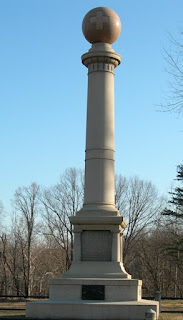 |
| This metal disk was customized to provide info about Weigel (NPS photos) |
Back in October, Matt Borders was on eBay, searching for anything
connected to the 138th Pennsylvania Infantry, a unit that was involved in extensive combat during the Civil War.
Borders, a park ranger at Monocacy National Battlefield near Frederick,
Md., came across something remarkable -- a rare identification Civil War badge
for sale. It bore the name of Pvt. Samuel M. Weigel, who fought with Company G
of the 138th at the July 9, 1864, Battle of Monocacy.
Civil War soldiers were afraid of dying in battle unidentified and being
laid in an unmarked grave -- their loved ones not knowing their fate. They often
would write their name on a piece of paper and attach it to their clothing. Better
yet would be a metal disk, such as the one Weigel purchased from a vendor. He likely
carried it during several campaigns, including Monocacy, where at age 24 he was
seriously wounded.
 |
| Matt Borders |
Borders spoke with others at the park about the find and whether it
could help further tell the story of the battle in which outnumbered Federals
delayed Confederates bent on taking Washington, D.C. By the time Jubal Early’s Rebel troops reached
the capital’s outskirts, Union reinforcements had arrived.
“We looked to see if it was within the
scope of the collection and it fits very nicely,” Jana
Friesen McCabe, chief of interpretation at the
park, told the Picket.
The National
Park Service cannot make purchases on eBay, so the Monocacy National Battlefield Foundation stepped in. The group paid about $1,700 for the tag from a reputable seller
on eBay and donated Weigel’s tag to the park, which announced the acquisition
last week.
 |
| The "final stand" at Monocacy battlefield (NPS) |
“It is amazing that after 157 years, this ID disk is returning to the battlefield,” said Andrew Banasik, superintendent of Monocacy National Battlefield, in the press release. “This small piece of metal is a tangible reminder of the price paid by so many to save Washington.”Telling more stories of the everyman
The donation comes at a fortuitous time
for the park.
“We are currently in the process of
planning to redo our exhibits, and one of the things we really wanted to
highlight and focus (on is) the individual stories of the soldier and the cost
of the battle to soldiers and people in the community,” said Friesen
McCabe. Among such items already in the
park’s collection is a Bible struck by a bullet during the fighting.
 |
| The silver ID tag for Sgt. Nicholas G. Wilson (NPS photos) |
The Union
suffered about 1,300 casualties at Monocacy. The 138th Pennsylvania,
which engaged in some of the fiercest fighting, suffered nearly 70, according
to its regimental history. Among the severely wounded were Weigel and Sgt.
Nicholas G. Wilson, also of Company G. Wilson was shot in the right hand,
losing two fingers.
The
battlefield already had Wilson’s identification tag. The foundation did not assist with its acquisition.
While Weigel’s disk is
believed to be made of copper alloy and customized from a mass-produced design, Wilson’s tag is silver and is in the shape of a shield. The reverse of Weigel's tag features an American stars and stripes shield and the words "AGAINST REBELLION."
“Before the United
States military provided standard issue identification tags – often called ‘dog
tags,’ -- soldiers had to find their own way to ensure their bodies could be
identified,” the park says. “Because soldiers had to purchase these tags with
their own money, there is no standardized style and no official record of how
many soldiers had them.”
The men of Company G came from towns in Adams County about 10
miles north of Gettysburg, Pa., according to the Battlefield Back Stories blog.
Wilson and Weigel were from the Bendersville farming community.
Wilson was a farmer and blacksmith before the conflict and served to its
end, mustering out in June 1865 after being hospitalized in Baltimore and York, Pa. (He is in the photo at left, part of the Library of Congress' collection.)
He had an impressive career afterward, serving
as superintendent at the national cemetery in Gettysburg for 15 years, on the
local city council and school board and as a state representative for two
years.
He died in 1907 at age 75, having worked for years to help develop the Gettysburg battlefield for visitors.
Samuel Meals Weigel’s story is not so well known, according to park
officials. He was married to Martha Ann Harmon and they had two boys and two
girls.
The retired carpenter died at age 82 in 1922 of intestinal nephritis,
according to his death certificate, and was buried in Harrisburg.
 |
| Jana Friesen McCabe has served 20 years with the NPS |
Park officials say they want to learn more about the private and any descendants. They do not have a photograph of the soldier.
“That is always the dream -- to make
those connections and learn if the family has stories to pass down,” said Friesen
McCabe.
“You find a little piece of something and you have to dig for the other nuggets
and threads associated with it.”
Regiment endured fierce fighting
The 138th Pennsylvania was
mustered in Harrisburg in 1862. While it missed the fighting at Gettysburg in
July 1863, it saw heavy action and casualties at the Wilderness, Cold Harbor
and other campaigns in Virginia.
At the November-December 1863 Battle of
Mine Run in Orange County, Va., Wilson, shown in a later photo at left, survived a bizarre incident.
“During the engagement a rebel bullet ripped through his knapsack -- in
which he had stored 40 rounds of ammunition. The bullet ignited those rounds,
and his knapsack was blown right off his back,” says Battlefield Back Stories. “Wilson
was otherwise unhurt, and lived to record the tale in a book of personal
wartime sketches individually recorded by members of the Corporal Skelly G.A.R.
Post 9, today preserved at the Adams County Historical Society.”
The regiment was assigned to the Army of Potomac’s VI Corps and took
part in Grant’s Overland Campaign. An estimated 27 soldiers with the 138th died
at the Wilderness.
In July 1864, the 138th and several other battle-hardened
regiments were rushed from Petersburg to Baltimore and by train to Monocacy to
help intercept Confederate troops, says Borders, the park ranger. Early had
invaded Maryland in a bold plan, and caught the North off-guard.
“They are part of the veteran soldiers
who were brought in, says Borders, saying the other half of the Federal troops
on site were green. “They are going to have the stiffest fighting along the
Thomas Farm portion of the battlefield. They will turn to guard against the
flank attack … that is attempting to roll up the Union line.”
By 5 p.m. on July 9, the much larger Confederate force had outstretched
the Federal flanks. Having run out of artillery ammunition, troops are ordered
by Maj. Gen. Lew Wallace (right) to leave the field and fall back toward Baltimore.
While a tactical victory for the South, the battle saved Washington by buying
time for Grant to rush men to defend the city.
The regimental history, which transposes the spelling of his name to
Wiegel, does not detail Weigel’s wounds. A regimental muster roll spells his
name as “Weigle,” says he enlisted in August 1862 and that he was absent
following his wounding.
 |
| Dedication of the Pennsylvania monument in 1908 (NPS photo) |
It is possible Weigel attended the November 1908 dedication of the
Pennsylvania monument at Monocacy. The memorial recognizes the service of the
67th, 87th and 138th regiments. About 200
survivors attended the event. (A modern view of the monument is below)
Are there any Weigel descendants?
It’s somewhat providential that Borders,
who collects carte de visites, or small portraits of soldiers, came across
Weigel’s ID tag, which includes the name Bendersville, his hometown, on the bottom.
Using his private eBay account, Borders every
few weeks types in the names of Federal regiments that were at Monocacy and
sees what comes up.
The ranger theorizes the artifact probably
came from an estate sale to a collector before being offered by the seller on
eBay, but officials at this early juncture don’t which descendants may have had
it and why it was not kept.“That is something we are actively working on,” he
said.
Borders and Friesen
McCabe say Weigel’s ID disk will help tell
the story of the battle, its aftermath and medical care (the National Museum of Civil War Medicine is in Frederick).
Alan Duke, president of the Monocacy National Battlefield
Foundation, told the Picket:
“The Foundation was very pleased to be able to
purchase the ID tag for the Battlefield's museum, especially since it will fit
in very nicely with an upcoming planned exhibit.”
Park
officials have no firm timetable for the revamped exhibits, but they stress the
Weigel tag will help highlight new stories.
“It is a tangible touchstone to talk
about Samuel, his injuries, the medical care, survival,” says Friesen McCabe. “A
lot of men survived their injuries but they are scarred for life.”

























